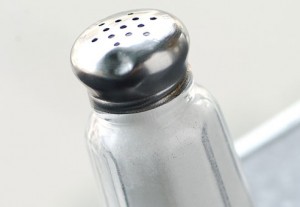 Like most of my over 40 patients, you likely include some convenience foods, i.e., packaged foods, fast foods, store prepared foods in your diet at least weekly. These are okay in moderation, but if you also add table salt to food you prepare at home, salt intake can build up to unhealthy levels. As I caution my patients, we need to be aware of how much salt we’re taking in daily to ensure that we stay near a healthy level.
Like most of my over 40 patients, you likely include some convenience foods, i.e., packaged foods, fast foods, store prepared foods in your diet at least weekly. These are okay in moderation, but if you also add table salt to food you prepare at home, salt intake can build up to unhealthy levels. As I caution my patients, we need to be aware of how much salt we’re taking in daily to ensure that we stay near a healthy level.
However, a “healthy level” for salt intake has become a controversial subject. The FDA states we should keep our salt intake levels under 2400 mg a day while the World Health Organization states an unbelievably high 6,000 mg a day! The Dietary Guidelines for Americans recommends about 1200-1500 mg is best if you are over the age of 50. Who’s right?
How Much Salt Do You Need?
As humans, we all need a certain amount of salt everyday to make our bodies function correctly. Salt helps our bodies do the following things:
- Keeps muscles contracting and relaxing properly
- Maintains the pathways of nerve impulses
- Controls the balance of fluids in your body
Adults need only about 250-500 mg sodium a day. Unfortunately, many Americans, especially those over 50, are getting too much salt in their diets, somewhere around 3400 mg a day! As a doctor, I know that too much salt holds too much water in the body and can lead to:
- Hypertension
- Kidney disease
- Stroke
- Congestive heart failure
Know The Source of Your Salt Intake
In order to control your salt intake at a healthy level, you need to know the salt content of the foods you eat. You can do this by reading labels and/or by buying a sodium content book. To give you some general guidelines, the following is a list of the highest salt foods to the lowest:
- Processed, store prepared foods: These include frozen foods, packaged foods like lunchmeats, cheeses, soups, meals-in-a-box, etc. Prepared foods made in the store deli/kitchen, carry-out foods like pizza, Chinese food, fast foods like the local burger/fries place, taco place, etc. Snack foods, like popcorn, chips, jerky, pretzels, corn puffs, etc, all contain high levels of salt. Read the labels. Salt content can be lurking in these various chemical names: sodium bicarbonate, disodium phosphate, baking powder, baking soda, sodium nitrate (in processed meats), sodium alginate.
- Table Salt, Condiments: As noted above 1 tsp of salt contains about 2,300 mg of sodium. Several shakes of the salt shaker a day could easily put at least ¼ to ½ tsp of salt on your food in addition to the sodium it may already contain. Condiments like ketchup, mustard, salad dressings, mayonnaise, soy sauce etc, can also contain a lot of salt.
- Uncooked Foods: Food in its uncooked state also contains natural sodium. Dairy products, shellfish, bacon, ham are higher salt foods.
- Green Foods: Fruits and vegetables are very low in sodium and contain potassium which helps regulate sodium intake. Also contain vital antioxidants for good health.
How To Control Your Salt Intake
As I advise my patients, there are several things you can do to keep your salt intake at a healthy level. Here’s what I tell them:
- Limit sodium to under 1200 mg. I agree with the researchers who say that keeping your sodium intake around 1,200 mg a day if you’re over age 50. I think this is the healthiest level to help your kidneys/heart work well. Too much salt makes you retain water and causes your heart and kidneys to work harder trying to clear the excess fluids.
- Limit processed/prepared foods: Keep intake low to moderate and adjust other food you eat to keep your salt intake healthy. Look for low sodium labels.
- Limit High Sodium Uncooked Foods: Higher sodium content foods like ham, shellfish and dairy can be worked into your diet on a low to moderate intake basis. I would limit the ham and shellfish to once a week, however, and include 2 servings of dairy a day.
- No/Low-Added salt: I prefer my patients not add any salt at all to their food, but I realize that this is not always possible. You can use lite salts that have half the sodium content, but still need to watch its use. “Natural” salt like sea salt is still salt and acts the same way in your body.
- Eat Fresh Produce: Include more naturally low salt fruits and vegetables.
- Spice Up Your Food: Experiment with herbs and spices, citrus rubs, etc. Make use of products like Mrs. Dash to add taste and flavor.
- Stay Hydrated: Drinking enough water not only hydrates you, it also can flush out excess sodium in your body. Especially when you eat higher sodium processed foods, be sure to drink more water with them.
As I caution my patients, keeping your salt intake to healthy levels is very important, especially after you pass the age of 50 when metabolisms, and kidney function, start to slow down naturally. However, there is no reason to have bland, tasteless food while maintaining a healthy sodium intake. Learning how to creatively cook your foods can really perk up their flavor and keep your taste buds satisfied while controlling your salt intake.
Stay well,
Mark Rosenberg, M.D.
Photo Credit: ericcressey.com
